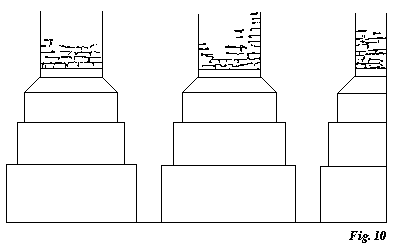CONSTRUCTION VII. THE PIER BASE 103
a reduction in diameter, in Fig. 2 as it is applied in Fig. 10, only I have not drawn the joints of the stones, because these would confuse the outlines of the bases; and I have not represented the rounding of the shafts, because it does not bear at present on the argument.) Now it would hardly be convenient, if we had to pass between the pillars, to have to squeeze ourselves through one of those angular gaps or brêches de Roland1 in Fig. 10. Our first impulse would be to cut them open; but we cannot do this, or our piers are unsafe. We have but one other resource, to fill them up until we have a floor wide enough to let us pass easily: this we may perhaps
 |
obtain at the first ledge, we are nearly sure to get it at the second, and we may then obtain access to the raised interval, either by raising the earth over the lower courses of foundation, or by steps round the entire building.
Fig. 11 is the arrangement of Fig. 10 so treated.
§ 7. But suppose the pillars are so vast that the lowest chink in Fig. 10 would be quite wide enough to let us pass through it. Is there then any reason for filling it up? Yes.
1 [“Roland’s breach,” a deep defile in the crest of the Pyrenees, near Gavarnie. The legend-that the paladin cleft the rock in two with his sword Durandal, when he was set upon by the Gascons at Roncesvalles-is referred to by Wordsworth:-
“Then would I seek the Pyrenean breach
Which Roland clove with huge two-handed sword.”
(Memorials of a Tour on the Continent: “Aix-la-Chapelle”).]
[Version 0.04: March 2008]